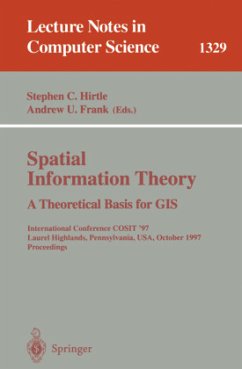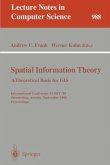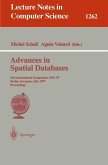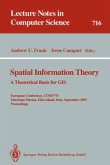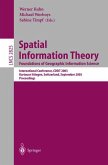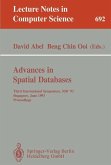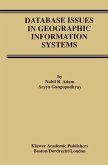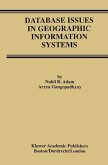HirtleInternational Conference COSIT '97, Laurel Highlands, Pennsylvania, USA, October 15-18, 1997. Proceedings
Spatial Information Theory A Theoretical Basis for GIS
International Conference COSIT '97, Laurel Highlands, Pennsylvania, USA, October 15-18, 1997. Proceedings
Mitarbeit:Hirtle, Stephen C.; Frank, Andrew U.
HirtleInternational Conference COSIT '97, Laurel Highlands, Pennsylvania, USA, October 15-18, 1997. Proceedings
Spatial Information Theory A Theoretical Basis for GIS
International Conference COSIT '97, Laurel Highlands, Pennsylvania, USA, October 15-18, 1997. Proceedings
Mitarbeit:Hirtle, Stephen C.; Frank, Andrew U.
- Broschiertes Buch
- Merkliste
- Auf die Merkliste
- Bewerten Bewerten
- Teilen
- Produkt teilen
- Produkterinnerung
- Produkterinnerung
This book constitutes the refereed proceedings of the 1997 International Conference on Spatial Information Theory, COSIT'97, held in Laurel Highlands, Pennsylvania, USA, in October 1997. The 31 revised full papers presented were carefully selected from a total of 66 submissions. Also included are seven posters. The volume is divided into sections on representations of change, structuring of space, boundaries and gradations, topological models of space, formal models of space, cognitive aspects of spatial acquisition, novel use of spatial information, wayfinding and map interpretation,…mehr
Andere Kunden interessierten sich auch für
![Spatial Information Theory: A Theoretical Basis for GIS Spatial Information Theory: A Theoretical Basis for GIS]() FrankSpatial Information Theory: A Theoretical Basis for GIS77,99 €
FrankSpatial Information Theory: A Theoretical Basis for GIS77,99 €![Advances in Spatial Databases Advances in Spatial Databases]() SchollAdvances in Spatial Databases39,99 €
SchollAdvances in Spatial Databases39,99 €![Spatial Information Theory: A Theoretical Basis for GIS Spatial Information Theory: A Theoretical Basis for GIS]() Andrew U. Frank / Irene Campari (eds.)Spatial Information Theory: A Theoretical Basis for GIS39,99 €
Andrew U. Frank / Irene Campari (eds.)Spatial Information Theory: A Theoretical Basis for GIS39,99 €![Spatial Information Theory. Foundations of Geographic Information Science Spatial Information Theory. Foundations of Geographic Information Science]() Werner Kuhn / Michael F. Worboys / Sabine Timpf (eds.)Spatial Information Theory. Foundations of Geographic Information Science39,99 €
Werner Kuhn / Michael F. Worboys / Sabine Timpf (eds.)Spatial Information Theory. Foundations of Geographic Information Science39,99 €![Advances in Spatial Databases Advances in Spatial Databases]() AbelAdvances in Spatial Databases39,99 €
AbelAdvances in Spatial Databases39,99 €![Database Issues in Geographic Information Systems Database Issues in Geographic Information Systems]() Nabil R. AdamDatabase Issues in Geographic Information Systems75,99 €
Nabil R. AdamDatabase Issues in Geographic Information Systems75,99 €![Database Issues in Geographic Information Systems Database Issues in Geographic Information Systems]() Nabil R. AdamDatabase Issues in Geographic Information Systems77,99 €
Nabil R. AdamDatabase Issues in Geographic Information Systems77,99 €-
-
-
This book constitutes the refereed proceedings of the 1997 International Conference on Spatial Information Theory, COSIT'97, held in Laurel Highlands, Pennsylvania, USA, in October 1997. The 31 revised full papers presented were carefully selected from a total of 66 submissions. Also included are seven posters. The volume is divided into sections on representations of change, structuring of space, boundaries and gradations, topological models of space, formal models of space, cognitive aspects of spatial acquisition, novel use of spatial information, wayfinding and map interpretation, representations of spatial concepts, new approaches to spatial information.
Produktdetails
- Produktdetails
- Lecture Notes in Computer Science 1329
- Verlag: Springer / Springer Berlin Heidelberg / Springer, Berlin
- Artikelnr. des Verlages: 10645632, 978-3-540-63623-6
- 1997.
- Seitenzahl: 532
- Erscheinungstermin: 1. Oktober 1997
- Englisch
- Abmessung: 235mm x 155mm x 29mm
- Gewicht: 792g
- ISBN-13: 9783540636236
- ISBN-10: 3540636234
- Artikelnr.: 09252961
- Herstellerkennzeichnung
- Springer-Verlag GmbH
- Tiergartenstr. 17
- 69121 Heidelberg
- ProductSafety@springernature.com
- Lecture Notes in Computer Science 1329
- Verlag: Springer / Springer Berlin Heidelberg / Springer, Berlin
- Artikelnr. des Verlages: 10645632, 978-3-540-63623-6
- 1997.
- Seitenzahl: 532
- Erscheinungstermin: 1. Oktober 1997
- Englisch
- Abmessung: 235mm x 155mm x 29mm
- Gewicht: 792g
- ISBN-13: 9783540636236
- ISBN-10: 3540636234
- Artikelnr.: 09252961
- Herstellerkennzeichnung
- Springer-Verlag GmbH
- Tiergartenstr. 17
- 69121 Heidelberg
- ProductSafety@springernature.com
Continuous change in spatial regions.- Qualitative representation of change.- Image-schemata-based spatial inferences: The container-surface algebra.- A city metaphor to support navigation in complex information spaces.- Using hierarchical spatial data structures for hierarchical spatial reasoning.- Structuring space with image schemata: Wayfinding in airports as a case study.- Fiat and bona fide Boundaries: Towards an ontology of spatially extended objects.- A representation-oriented taxonomy of gradation.- Classification as an impediment to the reliable and valid use of spatial information: A disaggregate approach.- What maps mean to people: Denotation, connotation, and geographic visualization in land-use debates.- The algebraic structure of sets of regions.- Complex regions in topological queries.- A cognitive assessment of topological spatial relations: Results from an empirical investigation.- Voronoï diagrams on line segments: Measurements for contextual generalization purposes.- A qualitative coordinate language of location of figures within the ground.- Identification of fuzzy objects from field observation data.- Long-term spatial representations from pictorial and textual input.- Feature accumulation and route structuring in distance estimations - An interdisciplinary approach.- The perception and cognition of environmental distance: Direct sources of information.- Improving multi-purpose GIS design: Participative design.- Self-organization, cities, cognitive maps and information systems.- Cognitive requirements on making and interpreting maps.- From knowledge to words to wayfinding: Issues in the production and comprehension of route directions.- Spatial representation for pragmatic navigation.- Partition and conquer.- Supporting emergence in spatialreasoning with shape algebras and formal logic.- Linear constraints: Geometric objects represented by inequalitiesl.- An event-based approach to spatial information.- Geocognostics - A new framework for spatial information theory.- Graphical modelling for geographic explanation.- Experiments using context and significance to enhance the reporting capabilities of gis.- Automatic summarization of radiographic imagery.- An automated system for name placement which complies with cartographic quality criteria: The hydrographic network.- Agent-based simulations of a city dynamics in a gis environment.- A logical approach to incorporating qualitative spatial reasoning into GIS (Extended Abstract).- User interaction in a sketch-based GIS user interface.- Metrical refinement of topological relations.- Approximation of topological relations between fuzzy regions satisfying a linguistically described query.
Continuous change in spatial regions.- Qualitative representation of change.- Image-schemata-based spatial inferences: The container-surface algebra.- A city metaphor to support navigation in complex information spaces.- Using hierarchical spatial data structures for hierarchical spatial reasoning.- Structuring space with image schemata: Wayfinding in airports as a case study.- Fiat and bona fide Boundaries: Towards an ontology of spatially extended objects.- A representation-oriented taxonomy of gradation.- Classification as an impediment to the reliable and valid use of spatial information: A disaggregate approach.- What maps mean to people: Denotation, connotation, and geographic visualization in land-use debates.- The algebraic structure of sets of regions.- Complex regions in topological queries.- A cognitive assessment of topological spatial relations: Results from an empirical investigation.- Voronoï diagrams on line segments: Measurements for contextual generalization purposes.- A qualitative coordinate language of location of figures within the ground.- Identification of fuzzy objects from field observation data.- Long-term spatial representations from pictorial and textual input.- Feature accumulation and route structuring in distance estimations - An interdisciplinary approach.- The perception and cognition of environmental distance: Direct sources of information.- Improving multi-purpose GIS design: Participative design.- Self-organization, cities, cognitive maps and information systems.- Cognitive requirements on making and interpreting maps.- From knowledge to words to wayfinding: Issues in the production and comprehension of route directions.- Spatial representation for pragmatic navigation.- Partition and conquer.- Supporting emergence in spatialreasoning with shape algebras and formal logic.- Linear constraints: Geometric objects represented by inequalitiesl.- An event-based approach to spatial information.- Geocognostics - A new framework for spatial information theory.- Graphical modelling for geographic explanation.- Experiments using context and significance to enhance the reporting capabilities of gis.- Automatic summarization of radiographic imagery.- An automated system for name placement which complies with cartographic quality criteria: The hydrographic network.- Agent-based simulations of a city dynamics in a gis environment.- A logical approach to incorporating qualitative spatial reasoning into GIS (Extended Abstract).- User interaction in a sketch-based GIS user interface.- Metrical refinement of topological relations.- Approximation of topological relations between fuzzy regions satisfying a linguistically described query.

